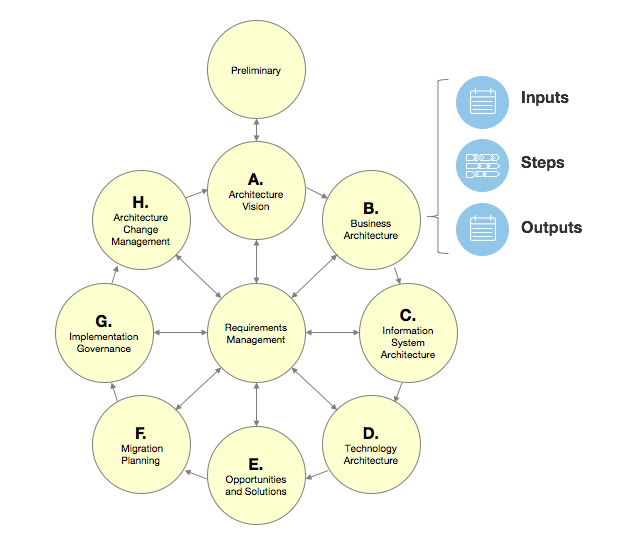TOGAF® is an open, industry-neutral enterprise architecture framework developed by the Open Group Architecture Forum. The core of TOGAF® is the Architecture Development Method (ADM), a method for creating systems or whole enterprise architectures [Kel11].
The TOGAF® framework is the de facto global standard for EAM. It is an open enterprise architecture framework, meaning that it is applicable across all industries [BBL12]. The Open Group Architecture Forum, comprising more than 200 enterprises, develops and maintains the TOGAF® standard and publishes successive versions at regular intervals. The latest release is TOGAF® version 9.1 published in late 2011 [11b].
The TOGAF® framework comprises a detailed method for developing architectures as well as a set of supporting tools [Kel11]. Generally, an architecture can be developed for single systems or subsystems, clusters of applications systems or for blueprints of the top level architecture of an enterprise [Kel11]. The term enterprise architecture is defined as “A formal description of a system, or a detailed plan of the system at component level to guide its implementation.” [11b].
The core of TOGAF® is the Architecture Development Method (ADM), a method describing the activities and artifacts necessary to transform an EA from a current state towards a target state [11b]. In order to do so, the ADM addresses a business need through a process of visioning, architecture definition, transformation planning, and architecture governance. The whole process consists of ten phases including the preliminary and the requirements management phase as depicted in Figure 1 [11b].

Figure 1: TOGAF® Architecture Development Method (ADM). [Based on: The Open Group. 2013. TOGAF Version 9.1.]
Each of these phases is split up into several steps necessary to achieve the goal of the respective phase [11b]. Additionally, for each phase a list of artifacts necessary as input and a list of documents that will be produced as output of the phase is given [11b]. The ADM is an iterative method, encouraging iterations over the whole process, between phases, and between steps [11b]. Further, it is a generic method, meaning that it is necessary to modify or extend the ADM to meet specific needs of certain enterprises [11b]. Summarizing, ADM can be seen as a condensed checklist guiding enterprise architects through the development of a certain architecture [Kel11].
Additional tools supporting the ADM are the Architecture Content Framework, the Enterprise Continuum, Reference Models and the Architecture Capability Framework[11b]. The Architecture Content Framework is a meta-model which is used for structuring and storing the artifacts produced during the execution of the ADM [11b; Kel11]. The Enterprise Continuum is a view on the repository, which stores all architecture artifacts an enterprise wants to re-use [11b]. Additionally, two reference models are provided, namely the Technical Reference Model (TRM) and the Integrated Information Infrastructure Reference Model (III-RM) [11b]. The major benefit of these two reference models is the establishment of an extensive taxonomy with regards to applications, application platforms and their communication infrastructure [11b]. Finally, the Architecture Capability Framework provides support on topics relevant for establishing an EAM function in an enterprise [11b; Kel11].
An advantage of TOGAF® is its compatibility with other recognized enterprise frameworks, meaning that the ADM can be used for developing the products associated with e.g. the Zachman, FEAF, TEAF or C4ISR/DoD framework [11b; Kel11]. Also, TOGAF® it is an internationally accepted standard and the ADM is a mature and extensive method [Kel11]. Additionally, trainings and certificates as well as TOGAF® compliant tools are available.
On the downside, TOGAF® version 9.1 has some 690 pages and is a major challenge to read, making it difficult for non-experts to get access to the topic. Further, strategic EAM tasks like IT strategy development or IT portfolio management are not addressed [Kel11]. Finally, the process description in the ADM is very generic and coarse-grained [Hau+14].
In summary, TOGAF® is a standard with an emphasizes on the development of architectures and not so much on other EAM tasks [Kel11]. Nevertheless, it enables organizations to foster a common language between stakeholders, avoids a lock-in on proprietary solutions for EAM and allows cost reduction due to the more effective use of EAM resources.
TOGAF® Version 9.1 can be downloaded or viewed online.
Sources:
|
[Kel11] |
W. Keller. TOGAF 9.1 Quick Start Guide for IT Enterprise Architects. Tech. rep. Wolfgang W. Keller, 2011. |
|
[BBL12] |
S. Bente, U. Bombosch, and S. Langade. Collaborative Enterprise Architecture: Enriching EA with Lean, Agile, and Enterprise 2.0 Practices. Elsevier, Inc., 2012. |
|
[11b] |
TOGAF® Version 9.1, an Open Group Standard. Standard. The Open Group, 2011. |
|
[Hau+14] |
M. Hauder, D. Münch, F. Michel, A. Utz, and F. Matthes. “Examining Adaptive Case Management to Support Processes for Enterprise Architecture Management.” In: 9th Trends in Enterprise Architecture Research Workshop (TEAR). Ulm, Germany, 2014. |